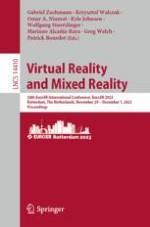2023 | Buch
Virtual Reality and Mixed Reality
20th EuroXR International Conference, EuroXR 2023, Rotterdam, The Netherlands, November 29 – December 1, 2023, Proceedings
herausgegeben von: Gabriel Zachmann, Krzysztof Walczak, Omar A. Niamut, Kyle Johnsen, Wolfgang Stuerzlinger, Mariano Alcañiz-Raya, Greg Welch, Patrick Bourdot
Verlag: Springer Nature Switzerland
Buchreihe : Lecture Notes in Computer Science
